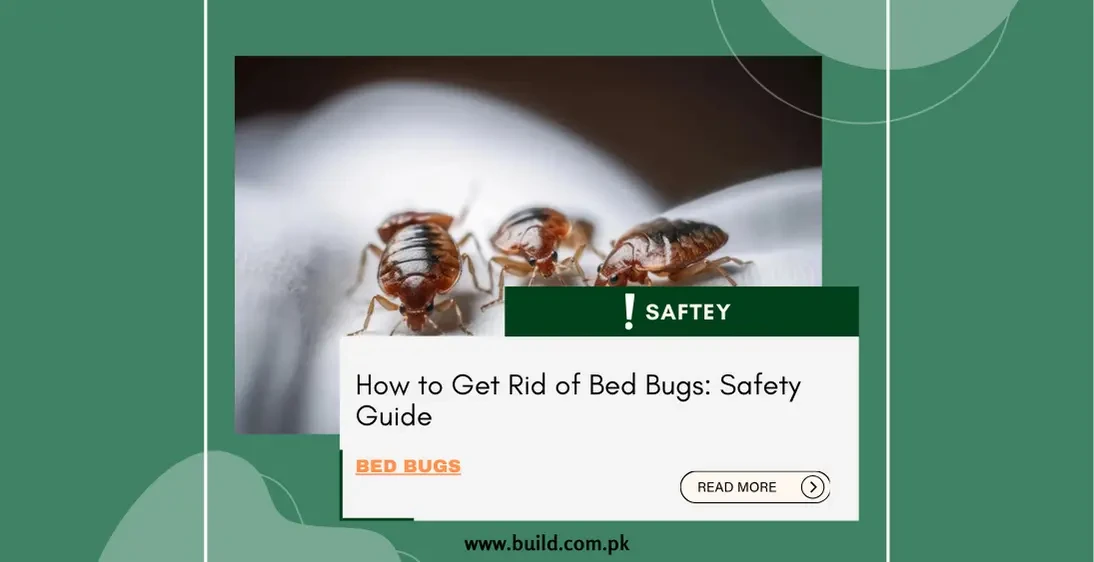How to Get Rid of Bed Bugs: Safety Guide

Introduction:
Dealing with a bed bug infestation can be a daunting and
frustrating experience, but with thorough and persistent efforts, you can
successfully eliminate these pests from your home. Bed bugs are small,
reddish-brown insects that feed on blood, typically at night while their hosts
are asleep. They can hide in cracks, crevices, furniture, and bedding, making
detection and eradication challenging.
Understanding the Problem: Identifying Bed Bugs
Bed bugs are small, reddish-brown insects that feed on blood,
typically at night while their host is asleep. They can hide in cracks,
crevices, furniture, and bedding, making them difficult to detect and
eradicate. Common signs of a bed bug infestation include itchy bites on the
skin, blood stains on sheets, and dark spots of bed bug excrement on mattresses
or furniture.Before initiating treatment, it's crucial to confirm the presence
of bed bugs through a detailed inspection:
Checking Common Hiding Spots:
Begin by thoroughly examining
your bedding, including mattresses, box springs, and bed frames, for signs of
bed bugs. Look for live insects, shed skins, eggs, or dark spots of bed bug
excrement.
Inspecting Furniture and Walls:
Bed bugs can also hide in
upholstered furniture, cracks in walls, electrical outlets, baseboards, and
carpet edges. Use a flashlight and magnifying glass to inspect these areas
carefully.
Monitoring for Bites:
Keep track of any unexplained bites on
your skin, especially after waking up. Bed bug bites often appear as red, itchy
welts in clusters or lines on exposed areas of the body.
Effective Methods to Eliminate Bed Bugs
Once you've confirmed a bed bug infestation, implement a
comprehensive approach combining multiple strategies to eradicate the pests:
Cleaning and Decluttering:
Start by thoroughly cleaning infested areas, including vacuuming mattresses, furniture, and floors. Dispose of clutter and unnecessary items to reduce potential hiding spots for bed bugs Launder all bedding, linens, and clothing in hot water (at least 120°F) followed by a high-heat drying cycle to kill bed bugs and their eggs.
Heat Treatment:
Use heat as a non-chemical method to eliminate bed bugs. Consider using a steam cleaner to treat mattresses, furniture, and carpets, as bed bugs are sensitive to high temperatures.Place infested items in a dryer on high heat for at least 30 minutes to ensure all bed bugs and eggs are killed.
Chemical Treatments:
Apply insecticides labeled for bed bugs to infested areas, following manufacturer instructions carefully. Focus on cracks, crevices, and hiding places where bed bugs are likely to hide.Consider hiring a licensed pest control professional for effective chemical treatments, especially for severe infestations.
Natural Remedies:
Explore non-toxic alternatives such as diatomaceous earth (a fine powder that dehydrates and kills bed bugs), essential oils (e.g., tea tree oil, lavender oil), or bed bug interceptors to repel and control bed bugs.Keep in mind that natural remedies may require repeated applications and may not be as effective as professional treatments.
Professional Bed Bug Treatment
For severe or persistent bed bug infestations, it's advisable
to seek professional pest control services:
- Expertise and Equipment: Pest control professionals have the knowledge, experience, and specialized equipment to effectively eliminate bed bugs using integrated pest management (IPM) techniques.
- Customized Treatment Plans: Professionals will assess the extent of the infestation and tailor treatment methods accordingly, often combining heat treatments, insecticides, and monitoring strategies for maximum effectiveness.
- Follow-Up Inspections: Reputable pest control companies offer
follow-up inspections to ensure that the bed bug infestation has been
eradicated completely.
Preventive Measures: Avoiding Future Infestations
After successfully eliminating bed bugs, take preventive
measures to prevent reinfestation:
- Regular Cleaning and Maintenance: Maintain cleanliness by vacuuming regularly, washing bedding frequently in hot water, and decluttering living areas.
- Sealing Entry Points: Seal cracks, crevices, and entry points around windows, doors, and baseboards to prevent bed bugs from entering your home.
- Use Protective Encasements: Invest in bed bug-proof mattress
and box spring encasements to protect against future infestations and detect
bed bugs early.
Conclusion:
In conclusion, tackling a bed bug infestation requires a systematic and persistent approach combining inspection, treatment, and preventive measures. By implementing a comprehensive strategy and utilizing effective methods—whether DIY or with professional assistance—you can successfully eliminate bed bugs and restore comfort and peace of mind in your home. Remember to be patient and thorough throughout the process, as complete eradication may take time and effort. If you encounter persistent infestations or require specialized treatment, don't hesitate to seek help from licensed pest control professionals. With determination and diligence, you can overcome the challenge of bed bugs and enjoy a bed bug-free living environment once again.









